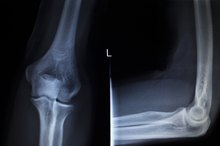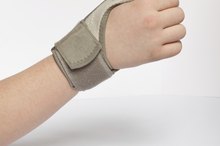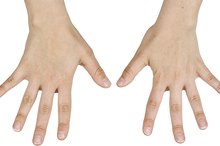Causes of Wrist and Elbow Joint Pain
Joint pain is caused by a variety of underlying conditions. Some are minor and heal on their own. Others are chronic and require ongoing medical care. Wrist and elbow joint pain can be caused by traumatic or overuse injury to multiple structures or by medical conditions such as arthritis. See your doctor for an accurate diagnosis if you have wrist or elbow joint pain. Many injuries cannot be detected without an x-ray or magnetic resonance imaging, or MRI.
Tendon Injury
Tendons connect muscle to bone. These structures attach close to your elbow and wrist joints, and inflammation may cause joint pain. Tendinitis is a common cause of elbow pain in particular. Tennis elbow and golfer's elbow describe tendon injuries that may affect athletes but are also common in the general population. Muscles that bend and straighten your wrist attach on either side of your elbow joint. Less commonly, tendinitis may occur in your wrist, particularly on the thumb side. Overuse of these muscles can occur with typing, sewing, use of hand tools and sports activities. Tendinitis is often treated with rest, nonsteriodal antiinflammatory medications such as:
- aspirin
- ibuprofen (Advil
- Motrin)
- naproxen (Aleve
- Naprosyn)
- as well as physical therapy
Cortisone injection and surgery may be required for some cases of tendon injury.
- Tendons connect muscle to bone.
- Overuse of these muscles can occur with typing, sewing, use of hand tools and sports activities.
Ligament Strain
What Are the Causes of Pain on Outer Side of Wrist?
Learn More
Ligaments are strong fibers of connective tissue that connect bone to bone. Injury to these structures occurs when fibers are overstretched, typically by trauma. Elbow and wrist ligaments can be overstretched by falling on an outstretched hand, for example. Severe stretching can cause dislocation, meaning bones in the joint move out of position. This requires immediate medical attention. Ligament strains in the wrist or elbow may cause sharp pain immediately after injury, as well as swelling or bruising. These injuries are often treated conservatively with physical therapy and splinting. Ligament injuries that lead to instability of your joints may require surgery.
- Ligaments are strong fibers of connective tissue that connect bone to bone.
- Severe stretching can cause dislocation, meaning bones in the joint move out of position.
Fractures
Bone fractures can affect the elbow and wrist. The radius bone on the thumb side of your wrist is frequently fractured -- most often when you attempt to catch yourself while falling. The opposite end of this bone, called the radial head, is part of your elbow joint. Radial head and other elbow fractures are also typically caused by trauma, such as a fall or motor vehicle accident. These injuries need immediate medical attention. Many fractures are immobilized with a cast or splint for 4 to 6 weeks. Complex fractures -- multiple bone fragments or bones that have moved out of place -- may require surgery.
- Bone fractures can affect the elbow and wrist.
- The radius bone on the thumb side of your wrist is frequently fractured -- most often when you attempt to catch yourself while falling.
Arthritis
What Causes Finger Joint Pain?
Learn More
Arthritis can affect any joint in your body. Osteoarthritis is caused by breakdown of the cartilage that provides padding between the bones in a joint 7. This condition may affect one or more joints in your body, typically affecting one side or the other. This type of arthritis is uncommon in the elbow joint 3. More often, arthritis develops after trauma to the joint. Wrist arthritis is common and often develops with bone disease or after a traumatic injury. Rheumatoid arthritis is an inflammatory condition that affects multiple joints in the body at the same time. This disease causes your body to mistakenly attack healthy joint tissue. Both types of arthritis may cause sharp pain with activity, aching at rest, limited movement of your joint and possibly swelling. Rheumatoid arthritis commonly affects the wrist and elbow joints 3. Treatment includes medication, activity modification and rest. Severe cases may require joint replacement surgery.
- Arthritis can affect any joint in your body.
- Treatment includes medication, activity modification and rest.
Related Articles
References
- Advances in Orthopedics: Elbow Dislocations -- A Review Ranging From Soft Tissue Injuries to Complex Elbow Fracture Dislocations
- Hand Clinics: The Epidemiology of Distal Radius Fractures
- Arthritis: Primary and Posttraumatic Arthritis of the Elbow
- Open Access Journal of Sports Medicine: Management of Tennis Elbow
- Journal of Hand and Microsurgery: Patient-Centered Care of de Quervain’s Disease
- Indian Journal of Orthopaedics: Surgical Management of Mason Type III Radial Head Fractures
- The Journal of Hand Surgery: Osteoarthritis of the Wrist
- Green's Operative Hand Surgery, 6th Edition; Scott Wolfe, M.D., et al. (eds.)
- Soojian MG, Kwon YW. Elbow Arthritis. Bulletin of the NYU Hospital for Joint Diseases. 2007;65(1):61-71.
- Fernandez-palazzi F, Rodriguez J, Oliver G. Elbow interposition arthroplasty in children and adolescents: long-term follow-up. Int Orthop. 2008;32(2):247-50. doi:10.1007/s00264-006-0299-0
- O'Driscoll SW. "Elbow Arthritis: Treatment Options" J Am Acad Orthop Surg November 1993 vol. 1 no. 2 106-116
Writer Bio
Aubrey Bailey has been writing health-related articles since 2009. Her articles have appeared in ADVANCE for Physical Therapy & Rehab Medicine. She holds a Bachelor of Science in physical therapy and Bachelor of Arts in psychology from the University at Buffalo, as well as a post-professional Doctor of Physical Therapy from Utica College. Dr. Bailey is also a certified hand therapist.








